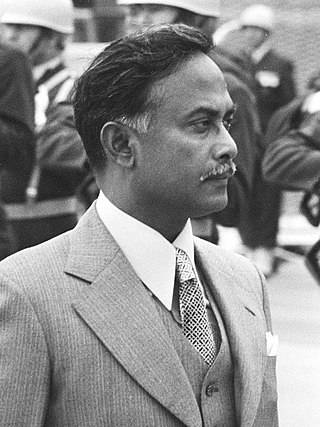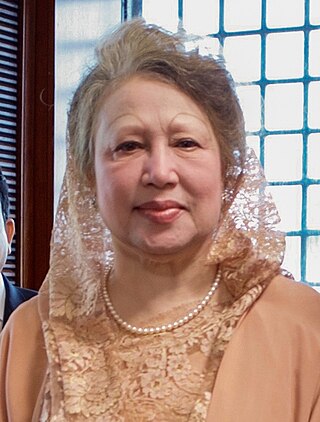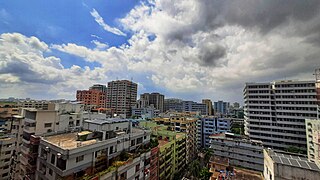
Dhaka, formerly known as Dacca, is the capital and largest city of Bangladesh. It is the ninth-largest and seventh-most densely populated city in the world. Dhaka is a megacity, and has a population of 10.2 million residents as of 2022, and a population of over 22.4 million residents in Dhaka Metropolitan Area. It is widely considered to be the most densely populated built-up urban area in the world. Dhaka is the most important cultural, economic, and scientific hub of Eastern South Asia, as well as a major Muslim-majority city. Dhaka ranks third in South Asia and 39th in the world in terms of GDP. Lying on the Ganges Delta, it is bounded by the Buriganga, Turag, Dhaleshwari and Shitalakshya rivers. Dhaka is also the largest Bengali-speaking city in the world.

Politics of Bangladesh takes place in a framework of a parliamentary representative democratic republic, whereby the Prime Minister of Bangladesh is the head of government, and of a multi-party system. Executive power is exercised by the government. Legislative power is vested in both the government and parliament. The Constitution of Bangladesh was written in 1972 and has undergone seventeen amendments.

Ziaur Rahman was a Bangladeshi military officer and politician who served as the President of Bangladesh from 1977 until his assassination. He was the founder of the Bangladesh Nationalist Party (BNP) and served as its chairman until his assassination. He previously served as the second chief of army staff from 1975 to 1978 with a minor break.

Begum Khaleda Zia is a Bangladeshi politician who served as the prime minister of Bangladesh from March 1991 to March 1996, and again from June 2001 to October 2006. She was the first female prime minister of Bangladesh and second female prime minister in the Muslim world, after Benazir Bhutto. She is the widow of former president of Bangladesh Ziaur Rahman. She is the chairperson and leader of the Bangladesh Nationalist Party (BNP) since 1984, which was founded by her late husband in 1978.

Shahbagh is a major neighbourhood and a police precinct or thana in Dhaka, the capital and largest city of Bangladesh. It is also a major public transport hub. It is a junction between two contrasting sections of the city—Old Dhaka and New Dhaka—which lie, respectively, to its south and north. Developed in the 17th century during Mughal rule in Bengal, when Old Dhaka was the provincial capital and a centre of the flourishing muslin industry, it came to neglect and decay in early 19th century. In the mid-19th century, the Shahbagh area was developed as New Dhaka became a provincial centre of the British Raj, ending a century of decline brought on by the passing of Mughal rule.

Paltan is a thana (precinct) of Dhaka, the capital of Bangladesh. It is often said to be the center of Dhaka, dividing "Old Dhaka" and "New Dhaka". Paltan was made a thana in 2005 by then Prime Minister Begum Khaleda Zia. Paltan Thana was formed on 27 June 2005 comprising part of Motijheel thana.

Ramna is a thana (precinct) in central Dhaka and a historic colonial neighbourhood. Once the site of Mughal gardens, it developed into an institutional area during British rule in the late 19th century. It became a focal point for Dhaka's modernisation in the 1960s. It was the scene of many tumultuous events that ushered the independence of Bangladesh in 1971. Ramna Thana falls under the jurisdiction of Dhaka South City Corporation.

Tejgaon is a thana of Dhaka District in the Division of Dhaka, Bangladesh. It is in the centre of Dhaka, the capital. In 2006, the boundaries of the thana were redrawn when Tejgaon Industrial Area Thana was created out of the former larger area and again in 2009 when Sher-e-Bangla Nagar Thana was created.

The culture of Bengal defines the cultural heritage of the Bengali people native to eastern regions of the Indian subcontinent, mainly what is today Bangladesh and the Indian states of West Bengal and Tripura, where they form the dominant ethnolinguistic group and the Bengali language is the official and primary language. Bengal has a recorded history of 1,400 years.

The history of Bangladesh (1971–present) refers to the period after the independence of Bangladesh from Pakistan.
Chowdhury Kamal Ibne Yousuf was a Bangladeshi politician who served as government minister.

Mohammad Mosaddak Ali, also known as Phalu, is a Bangladeshi entrepreneur and a politician who was a former parliamentarian from Bangladesh Nationalist Party (BNP). He served as the political secretary to the Prime Minister of Bangladesh Begum Khaleda Zia between 2001 and 2004. He was responsible for building special relations and partnership for development between the government and the private sector that is interested in investing in new and highly potential industrial sectors, and introducing new products and services to local industries, at a time when Bangladesh's economic growth accelerated. In 2003, Ali launched Bangladesh's first automation-based private satellite television station NTV. He also founded another satellite channel RTV and Bengali daily newspaper Amar Desh. He is the founding President of Association of Television Channel Owners (ATCO).

Dhaka is the most populous city of Bangladesh and is characterized by its busy urban life with varied culture including many festivities, a variety of cuisine, an entertainment industry, shopping experiences and sites of interest. These nature of these activities mirrors the secular character of the city's population. Important holidays include Language Movement Day, Independence Day, Victory Day and Pahela Boishakh. Religious festivals include Eid ul-Fitr, Eid ul-Adha, Durga Puja, Buddha Purnima etc. Dhaka is known as the center of media and cinema of Bangladesh, housing many of Bangladesh's important academies. The culture of Dhaka is based on the culture of Bengal.

Swadhinata Stambha or Independence Monument is a national monument in Bangladesh to commemorate the historical events that took place in the Suhrawardy Udyan, previously known as Ramna Race Course ground regarding the Liberation War of Bangladesh.
Nagorik Natya Sampradaya is a Bangladeshi theatre company. Established in 1968, it was the first theatre group in Dhaka and started performing plays on stage in 1972. The chairperson of the group is the actor and director Aly Zaker and his wife, actress Sara Zaker, is the vice-chairperson. As of December 2018, Nagorik had performed 46 different productions.

The Old Dhakaites are an Indo-Aryan cultural group viewed as the original inhabitants of Dhaka. They are sometimes referred to as simply Dhakaites or Dhakaiya. Their history dates back to the Mughal period with the migration of Bengali cultivators and merchants to the city. The cultivators came to be known as Kutti and they speak Dhakaiya Kutti, a dialect of Bengali and the merchants came to be known as Khoshbas and speak Dhakaiya Urdu. There are sizeable populations in other parts of Bangladesh. The Old Dhakaiyas maintain a distinct regional identity in addition to their ethnic Bengali identity, due to cultural, geographical and historical reasons. They have been described as a wealthy but very closed-off community; evidently being a minority in their own hometown. It is said that some people living in Greater Dhaka are even unaware of the existence of an Urdu-speaking non-Bihari minority community although their presence dates back centuries.
Kamar Jehan Sekandra Begum, better known as Begum Dolly Azad, was an East Pakistani politician.
A. N. M. Bashir Ullah is a Bangladesh justice of Bangladesh High Court.

Segunbagicha is an upscale residential, administrative, commercial, and institutional neighbourhood in south-central Dhaka. The neighbourhood is one of the important areas of Dhaka featuring a large number of government and residential complexes. It acts as a bridge between the major thanas of Ramna, Shahbagh, Dhanmondi, Paltan and Motijheel, and is located at the crossroads of Ramna, Shahbag and Paltan thanas.























